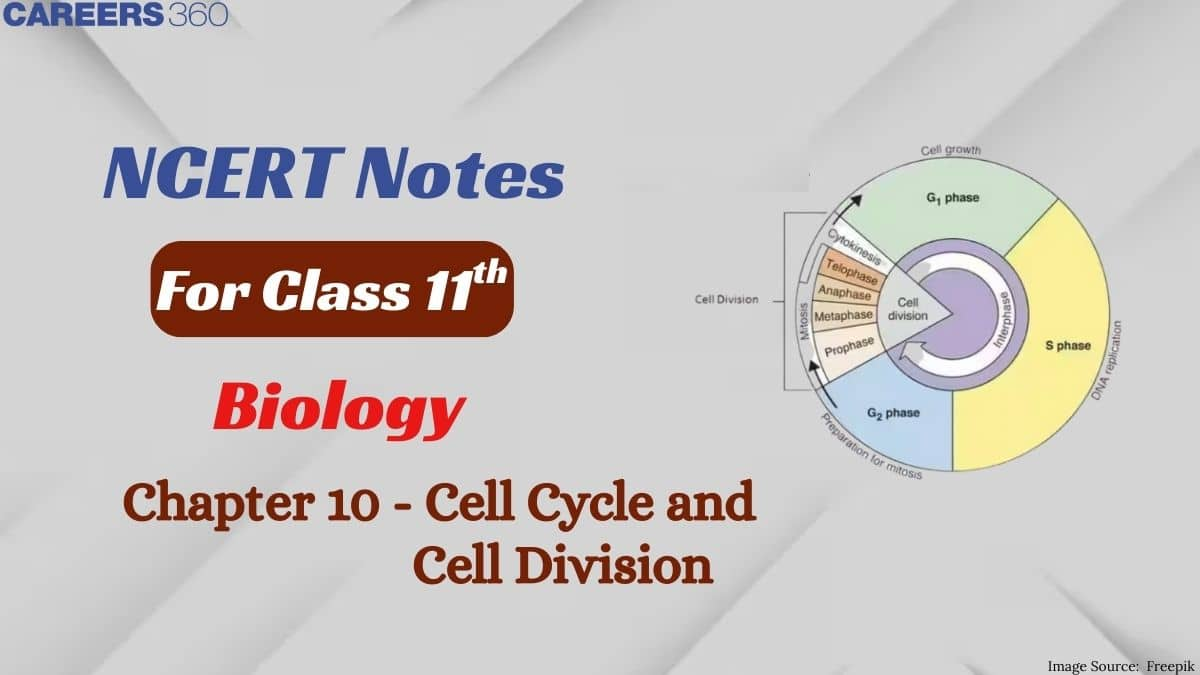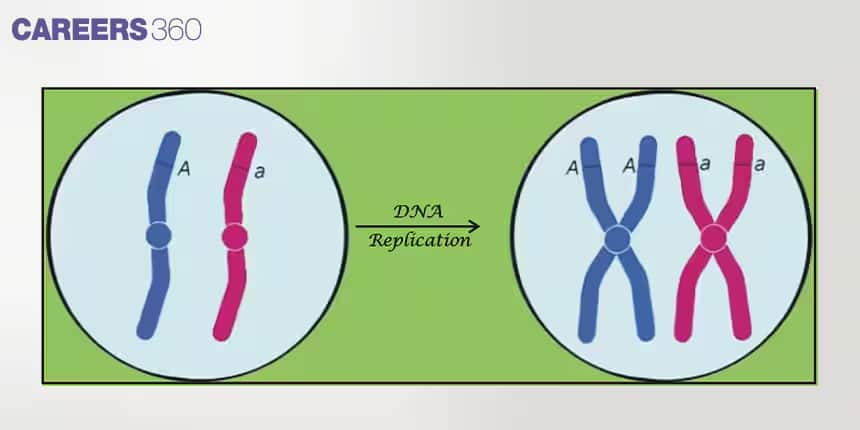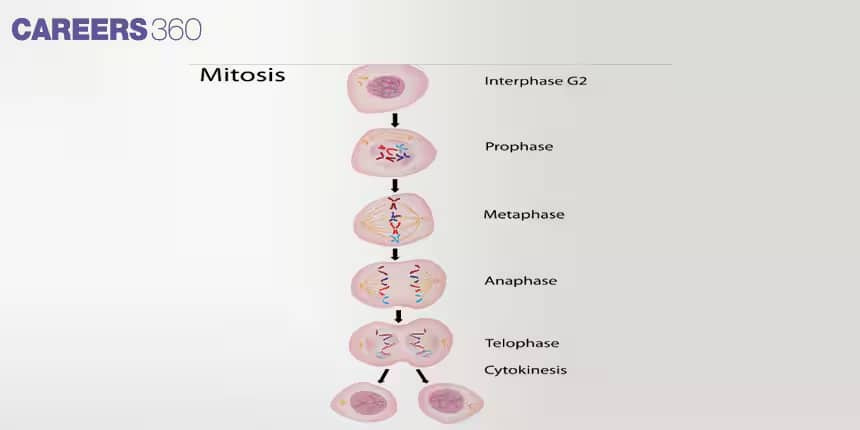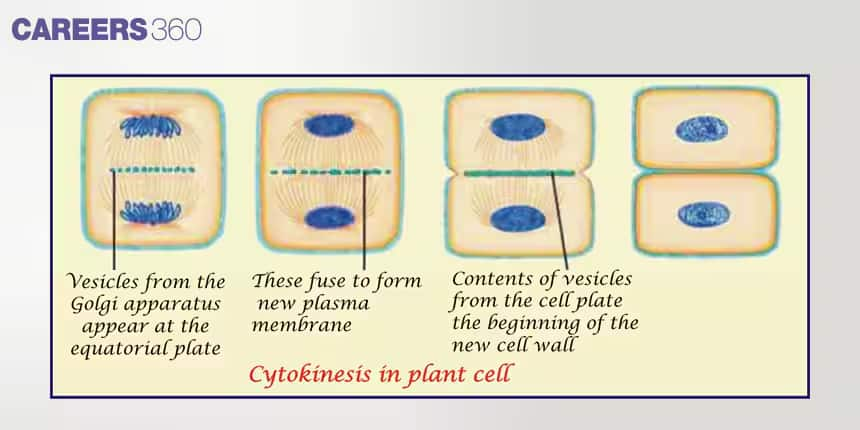NCERT Class 11 Biology Chapter 10 Notes Cell Cycle And Cell Division- Download PDF
Have you ever wondered how living things grow and repair themselves? The NCERT Class 11 Biology Chapter 10 Notes Cell Cycle and Cell Division explain the phases of the cell cycle, and how mitosis and meiosis happen. All the processes are explained clearly and simply. These notes include easy points, labelled diagrams, and solved previous-year questions so students can revise without confusion. The NCERT Notes are a valuable resource for revising in a very short time.
This Story also Contains
- NCERT Class 11 Biology Chapter 10 Notes: Download PDF
- Class 11 Biology Chapter 10 Cell Cycle and Cell Division Notes
- Cell Cycle and Cell Division Previous Year Question and Answers
- How to Use Cell Cycle and Cell Division Class 11 Notes Effectively?
- Advantages of Class 11 Biology Chapter 10 Cell Cycle and Cell Division Notes
- Chapter-Wise NCERT Class 11 Notes Biology

In the Cell Cycle and Cell Division Class 11 Notes, students will get clear explanations for each stage of cell division along with diagrams. The notes also guide them on writing clear and correct answers with the right terms. Students can download the PDF of NCERT Class 11 Biology Chapter 10 Notes to improve learning. By going through the NCERT Notes for Class 11, learners can build a solid understanding of the topic and feel confident in the school exams and competitive exams like NEET.
NCERT Class 11 Biology Chapter 10 Notes: Download PDF
The Cell Cycle and Cell Division chapter explains how cells grow, divide, and multiply to form new cells. Important stages like interphase, mitosis, and meiosis are also discussed. Students can download the NCERT Class 11 Biology Chapter 10 Notes PDF from the link given below. Studying from a downloaded PDF file helps in focusing on just the important points without wasting time. The NCERT Class 11 Biology Notes are important for quick and smart revision.
Also, students can refer to:
Class 11 Biology Chapter 10 Cell Cycle and Cell Division Notes
Students will understand why cell division matters to keep life going and pass on genes. This chapter talks about how cells grow, copy their DNA, and then divide into new cells. The Cell Cycle and Cell Division Class 11 Notes are prepared according to the NCERT guidelines, which help students understand the complex topics easily.
What is the Cell Cycle?
The cell cycle refers to the chain of linear events that the cell goes through during its lifespan, from initiation to division into two daughter cells. It is a vital process in the growth, development, repair, and reproduction of all organisms. The cell cycle helps genetic material be accurately duplicated and transferred to ensure there is genetic stability. Accurate control of the cell cycle is necessary to avoid a process of unchecked cell growth that may result in conditions such as cancer.
Phases of the Cell Cycle
The cell cycle is broadly divided into two major phases:
Interphase (Preparation Phase)
Interphase is the longest phase of the cell cycle, where the cell grows, replicates its DNA, and prepares for division. It is further divided into three sub-phases:
G₁ Phase (First Gap Phase):
The cell grows in size and synthesises proteins and organelles.
It prepares for DNA replication.
The G₁ checkpoint ensures conditions are favourable for DNA synthesis.
S Phase (Synthesis Phase):
DNA replication occurs, doubling the genetic material.
Each chromosome duplicates to form two identical sister chromatids.
The number of chromosomes remains the same, but the amount of DNA doubles.
G₂ Phase (Second Gap Phase):
The cell continues to grow and prepares for mitosis.
Proteins required for cell division are synthesised.
The G₂ checkpoint ensures DNA replication is error-free before proceeding to mitosis.

2. M Phase (Mitotic Phase – Cell Division Phase)
The M phase is the division phase, where the duplicated genetic material is evenly distributed into two daughter cells. It consists of:
Karyokinesis (Nuclear Division): Includes mitosis (for somatic cells) or meiosis (for gametes).
Cytokinesis (Cytoplasmic Division): Division of the cytoplasm to form two separate daughter cells.
Mitosis: The Process of Somatic Cell Division
Mitosis is a form of cell division in which one parent cell divides to give rise to two genetically equivalent daughter cells, each having the same number of chromosomes as the parent cell. It takes place in somatic (body) cells and plays a critical role in growth, repair, and asexual reproduction.

Significance of Mitosis
Retains the number of chromosomes (diploid to diploid).
Preserves genetic stability by forming the same cells.
Assists in tissue development and repair by replacing old or broken cells.
It is very important in asexual reproduction in unicellular organisms such as Amoeba.
Stages of Mitosis
Mitosis consists of four primary stages:
1. Prophase (Initiation of Cell Division)
Chromatin condenses into observable chromosomes, each made up of two sister chromatids united by a centromere.
The nucleolus and nuclear membrane dissolve.
Centrosomes migrate towards opposite poles, and the mitotic spindle (formed of microtubules) forms.
2. Metaphase (Chromosome Alignment)
Chromosomes align on the equatorial plane (metaphase plate).
Spindle fibres bind to the chromosomes' centromeres.
This step is significant to ensure proper chromosome separation.
3. Anaphase (Chromatid Separation)
Sister chromatids move apart as spindle fibres draw them toward opposite poles.
After separation, each chromatid is a daughter chromosome.
This guarantees each daughter cell has an equal number of chromosomes.
4. Telophase (Mitosis End)
Chromosomes decondense into chromatin.
The nucleolus and nuclear membrane reappear to form two distinct nuclei.
The spindle fibres break down.
Cytokinesis: Final Step of Cell Division
After mitosis, the cytoplasm divides in a process called cytokinesis, forming two identical daughter cells.
In animal cells, a cleavage furrow forms and pinches the cell into two.
In plant cells, a cell plate forms, developing into a new cell wall.

Role of Mitosis in Growth, Repair, and Asexual Reproduction
Mitosis increases the number of cells, helping in the growth of an organism from a single fertilised egg to a multicellular body.
Essential for embryonic development and organ formation.
Damaged or dead cells are replaced through mitosis (e.g., skin, blood, and liver cells).
Helps in wound healing and tissue regeneration (e.g., starfish regrowing limbs).
In unicellular eukaryotes (e.g., amoeba, some protozoa, yeast), mitosis or mitosis-like division enables asexual reproduction (binary fission in some protists and budding in yeast). Bacteria divide by binary fission but do not undergo mitosis.
Allows plants to propagate through vegetative reproduction (e.g., potato tubers, strawberry runners).
Meiosis
Meiosis is a reproductive cell division that takes place in germ cells (sperm and egg cells) by halving the number of chromosomes. It produces a haploid (n) gamete from a diploid (2n) parent cell. This way, when a fertilisation process happens, the zygote resulting from it re-establishes a diploid number, thus ensuring stability in the species' chromosomes.
Meiosis consists of two successive divisions:
Meiosis I (Reductional Division)
The stages of meiosis I include
Prophase I:
Chromatin condenses into chromosomes.
Homologous chromosomes pair up (synapsis) to form tetrads.
Crossing over (genetic exchange) occurs at chiasmata, ensuring variation.
The nuclear membrane dissolves, and spindle fibres form.
Metaphase I:
Homologous chromosome pairs align at the metaphase plate.
Independent assortment of homologous chromosomes occurs, increasing variation.
Anaphase I:
Homologous chromosomes separate and move to opposite poles, but sister chromatids remain together.
Telophase I and Cytokinesis:
Chromosomes decondense, and two haploid daughter cells are formed.
Meiosis II (Equational Division)
The stages of meiosis II include:
Prophase II:
Chromosomes condense again. Spindle fibres reappear.
Metaphase II:
Chromosomes align at the metaphase plate, similar to mitosis.
Anaphase II:
Sister chromatids separate and move to opposite poles.
Telophase II and Cytokinesis:
Nuclear membranes reform, and four genetically unique haploid cells are produced.
How Meiosis Provides Genetic Variation
Meiosis adds genetic diversity by:
Crossing Over (Prophase I): Homologous chromosomes swap genetic information, forming new combinations of alleles.
Independent Assortment (Metaphase I): Random allocation of pairs of homologous chromosomes results in various genetic combinations.
Significance of Cell Cycle and Cell Division
The importance of the Cell Cycle and Cell Division is as follows:
Growth, Development, and Tissue Repair
Mitosis facilitates organism growth by adding to the number of cells.
Critical for embryonic development and organogenesis.
Replaces dead or damaged cells, contributing to wound healing and tissue regeneration.
Function in Preserving Chromosome Number in Organisms
Mitosis maintains daughter cells that receive the same genetic material, retaining the chromosome number.
Meiosis halves the chromosome number in gametes, avoiding doubling in every generation and species stability.
Genetic Stability and Variations
Mitosis ensures genetic stability by resulting in identical cells.
Meiosis enhances genetic variety, which is essential for evolution and adaptation.
Differences Between Mitosis and Meiosis
The difference between Mitosis and Meiosis is given in the table below:
Feature | Mitosis | Meiosis |
Purpose | Growth, repair, and asexual reproduction | Formation of gametes (sexual reproduction) |
Number of Divisions | One | Two |
Daughter Cells | Two (diploid, 2n) | Four (haploid, n) |
Genetic Variation | Genetically identical daughter cells (barring rare mutations) | Genetic recombination due to crossing over |
Occurs In | Somatic cells | Germ cells |
Chromosome Number | Maintained (2n → 2n) | Reduced (2n → n) |
Significance | Tissue growth and maintenance | Genetic diversity and evolution |
Also Read
Cell Cycle and Cell Division Previous Year Question and Answers
Some of the questions which have come up in past years from the chapter are given below. To solve these questions effectively, students can once read the Class 11 Biology chapter 10 notes.
Question 1. Meiosis occurs in organisms during
Option 1. Sexual reproduction
Option 2. Vegetative reproduction
Option 3. Both sexual and vegetative reproduction
Option 4. None of the above
Answer :
In sexually reproducing animals, meiosis is a sort of cell division that lowers the number of chromosomes in gametes, also known as sex cells, or egg and sperm. Human somatic cells are diploid (2n) - they contain two homologous sets of chromosomes (one set originally derived from each parent at fertilisation).
Hence, the correct answer is option (1) Sexual reproduction
Question 2. Which of the events listed below is not observed during mitosis?
Option 1. Crossing over
Option 2. Movement of centrioles to opposite poles
Option 3. The appearance of chromosomes with two chromatids joined together at the centromere.
Option 4. Chromatin condensation
Answer :
During prophase I of meiosis, homologous chromosomes exchange genetic material, a process known as crossing over.
Although it does not happen during mitosis, this procedure guarantees genetic variety in gametes.
No genetic material is exchanged during mitosis; instead, it is primarily concerned with the equal division of genetic material to create two daughter cells that are genetically identical.
During mitosis, other processes are seen, including spindle formation, sister chromatid separation, and chromosomal condensation.
Hence, the correct answer is option (1) Crossing over
Question 3. A bivalents of meiosis I consists of
Option 1. Four chromatids and two centromeres
Option 2. Two chromatids and two centromeres
Option 3. Two chromatids and one centromere
Option 4. Four chromatids and four centromeres
Answer :
During meiosis, two homologous chromosomes couple up to produce a bivalent. When two homologous chromosomes pair, a bivalent comprises a total of four chromatids, since each chromosome is made up of two sister chromatids.
A bivalent, on the other hand, has two centromeres rather than four. This is because every chromosome has a single centromere, and the bivalently homologous chromosomes both maintain their own.
Hence, the correct answer is option (1): Four chromatids and two centromeres.
Question 4. The stage of mitosis in which sister chromatids separate and move towards opposite poles is
Option 1. Prophase
Option 2. Metaphase
Option 3. Anaphase
Option 4. Telophase
Answer:
During anaphase, the centromeres split, allowing sister chromatids to separate and move toward opposite poles of the cell. This movement ensures that each daughter cell receives an identical set of chromosomes, making anaphase one of the most crucial steps in mitotic division.
Hence, the correct answer is option (3) Anaphase
Question 5. Synapsis, a key event of meiosis, occurs during
Option 1. Leptotene
Option 2. Zygotene
Option 3. Pachytene
Option 4. Diplotene
Answer:
Synapsis is the process where homologous chromosomes pair tightly along their lengths. This event takes place during the zygotene stage of prophase I in meiosis. Proper synapsis ensures accurate crossing over and genetic recombination, contributing to genetic variation in gametes.
Hence, the correct answer is option (2) Zygotene
How to Use Cell Cycle and Cell Division Class 11 Notes Effectively?
Understanding how cells grow and divide helps us know how organisms develop, repair tissues, and even fight diseases. With the right notes, this chapter becomes easier to revise and apply in exams.
Study the complete process into different stages, like interphase, mitosis, and meiosis, to understand the sequence clearly.
Revise Class 11 Biology Chapter 10 Cell Cycle and Cell Division Notes PDF regularly so that terms like cytokinesis and spindle formation stay fresh in memory.
Use diagrams of the cell cycle and stages of division during exam preparation.
Solve past questions using the Class 11 Biology Chapter 10 Cell Cycle and Cell Division Notes, as many exams ask questions from this chapter.
Highlight key differences between mitosis and meiosis in the notes for quick revision before tests.
Advantages of Class 11 Biology Chapter 10 Cell Cycle and Cell Division Notes
The cell cycle and cell division chapter includes fundamental topics that explain how cells grow and reproduce. Well-organised notes offer several advantages to students, some of which are listed below:
- Class 11 Biology Chapter 10 Cell Cycle and Cell Division Notes PDF provides a clear explanation of each cell cycle phase, including interphase and mitotic stages.
- Important diagrams and flow charts have been added in the notes to allow students to improve their visual memory and better retention of concepts.
- These notes make it easier to answer application-based and diagram-based questions accurately and easily.
- Regular revision of the notes improves conceptual understanding by which students can perform well in school exams and competitve exams like NEET.
Also Read:
Chapter-Wise NCERT Class 11 Notes Biology
Below are all the chapter-wise links presented in a simple and easy-to-understand table format to help with quick revision and learning.
Frequently Asked Questions (FAQs)
The cell cycle is a series of events that a cell undergoes during its life, including growth, DNA replication, and division. It ensures the formation of new cells, essential for growth, repair, and reproduction in living organisms.
The cell cycle has two major phases, which are explained in the NCERT Class 11 Biology Chapter 10 Notes Cell Cycle and Cell Division:
Interphase (G₁, S, G₂) – Period of growth and DNA replication.
M Phase (Mitosis/Meiosis and Cytokinesis) – The division phase where the nucleus and cytoplasm split.
Interphase is the longest phase and consists of:
G₁ Phase: Cell growth and preparation for DNA replication.
S Phase: DNA replication occurs.
G₂ Phase: The Cell prepares for mitosis by synthesising proteins
Mitosis is the process of nuclear division in somatic cells, producing two identical daughter cells. It ensures growth, repair, and maintenance of tissues while also maintaining the chromosome number in a species. This process is explained in detail in the NCERT Class 11 Biology Chapter 10 Notes Cell Cycle and Cell Division.
Prophase: Chromosomes condense, spindle fibers form.
Metaphase: Chromosomes align at the center.
Anaphase: Sister chromatids separate and move to poles.
Telophase: Nuclear membrane reforms, chromosomes decondense.
Animal Cells: A cleavage furrow forms, pinching the cell into two.
Plant Cells: A cell plate forms, developing into a new cell wall.
Meiosis is a reductional cell division that produces haploid gametes (sperm and egg cells). It is essential for sexual reproduction, ensuring genetic diversity and maintaining chromosome numbers across generations.
Courses After 12th
Applications for Admissions are open.
As per latest syllabus. Physics formulas, equations, & laws of class 11 & 12th chapters
JEE Main Important Chemistry formulas
Get nowAs per latest syllabus. Chemistry formulas, equations, & laws of class 11 & 12th chapters
JEE Main high scoring chapters and topics
Get nowAs per latest 2024 syllabus. Study 40% syllabus and score upto 100% marks in JEE
JEE Main Important Mathematics Formulas
Get nowAs per latest syllabus. Maths formulas, equations, & theorems of class 11 & 12th chapters
